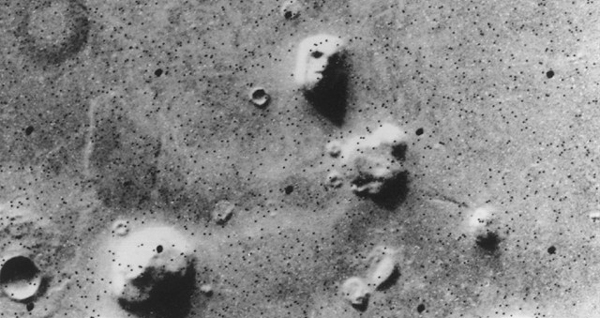Dip into the fascinating fields of geocognition and geocommunication with our December issue
Whitchurch, A., A geoscientist’s mind.
Geoscientist 28 (11), 5, 2018
https://doi.org/10.1144/geosci2018-026; Download the pdf here

Image: Face on Mars (credit: NASA/JPL-Caltech)
With improved understanding of how people learn and make decisions, can we tailor our teaching and communication tools to enhance learning efficacy and audience engagement? This idea, when applied to the geosciences, is the philosophy behind geocognition—the science of how people perceive and understand the Earth and Earth processes.
Geocognition is a relatively nascent field, but is gaining traction and has significance beyond the realms of formal education. In an era of fake news and public distrust of science, geocognitive research, when applied to communication techniques, could help scientists restore faith and reconnect with communities.
Geoscientific practices require essential cognitive skills. A geoscientist uses spatial thinking to recognise patterns and classify objects, to use and make maps, and visualise processes in three dimensions, ranging from microscopic to planetary in scale; they use temporal thinking to reconstruct sequences over timescales that are unfathomable to many; and they use systemic thinking to link observable features to their formational processes.
These cognitive skills are highly tuned in the experienced geoscientist compared to the novice. Experts are adept at rapidly filtering patterns from background noise—be that structures from noisy seismic sections, or bedding planes and lithological contrasts from fractured, weathered outcrops—and inferring links to conceptual models of formation. A preliminary investigation into field mapping skill (Petcovic et al.,
J.Geosci. Educ. 2009), for example, highlights novice-expert differences in both the approach to mapping and the final product. Interestingly, this study also reveals significant disparities between the maps produced by different experts. We view geological maps as objective representations of Earth, but they can be encumbered with personal bias.
Indeed, as explored in two features in this issue, the human brain is primed to draw meaningful connections, such as significance in lottery numbers, or to see patterns, such as the face on Mars, even where none truly exist. John Armitage and Tom Coulthard argue that testing data against predictive laboratory and numerical models can reduce bias, while Emma Jude calls on the techniques of fine artists to maintain objectivity in field sketches.
While we can put in place protocols to improve geoscientists’ interpretational accuracy, it’s impossible to remove subjectivity altogether. Like art, science requires a combination of technical competence and creativity, so that the final product is a translation of “a situation and a state of mind” (Osbourn,
Nat. Rev. Microbio. 2006).
In a third feature in this issue, Mike Stephenson observes commonalities between the poets Seamus Heaney and Ted Hughes, and scientists in their attempts to describe and understand the world around them. But he also notes an important contrast, suggesting that unlike poets, scientists don’t always take care with their words. Certainly, Heaney’s description of a bog body and Hughes’ take on the water cycle have replayed in my mind and stayed with me far longer than any description of these topics I’ve encountered in a journal article, text book or lecture theatre. Words are powerful and we should use them, creatively where possible, to reconnect our science to society.
Further reading
Petcovic,H.L., Libarkin, J.C. & Baker, K.M. (2009) An empirical methodology for investigating geocognition in the field.
Journal of Geoscience Education 57 (4), 316-328.
Osbourn, A (2006). The poetry of science.
Nature Reviews Microbiology 4, 77–80.
Earth and Mind: How Geologists Think and Learn about the Earth, by Manduca, C.A., Mogk, D.W. (eds),
Geological Society of America 2006.
Earth and Mind II: A Synthesis of Research on Thinking and Learning in the Geosciences, by Kastens, K.A. & Manduca, C.A. (eds),
Geological Society of America 2012.
The Geocognition Research Laboratory at Michigan State University:
https://geocognitionresearchlaboratory.com/research-in-the-grl/about/
Poetry and geology at the Geological Society of London:
https://www.geolsoc.org.uk/geopoetry
https://www.geolsoc.org.uk/Events/Past-Meeting-Resources/Poetry-and-Geology-A-Celebration/Further-resources